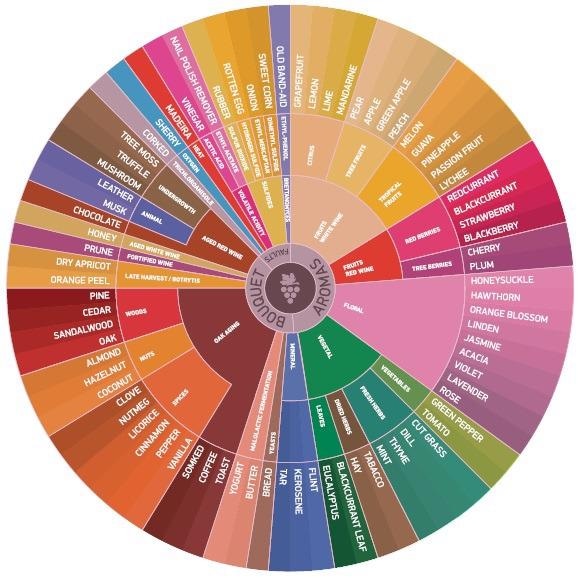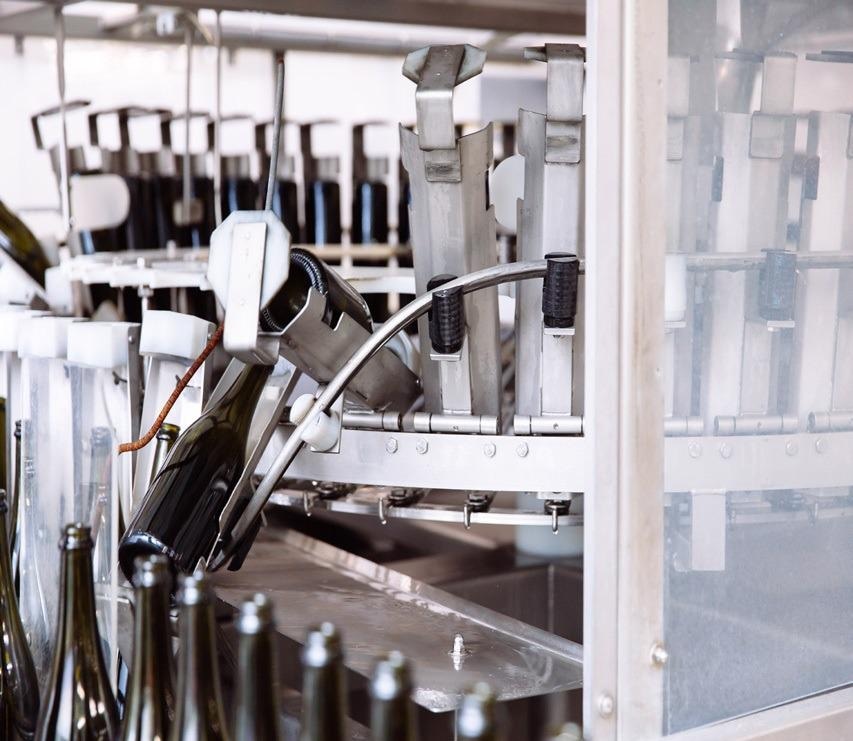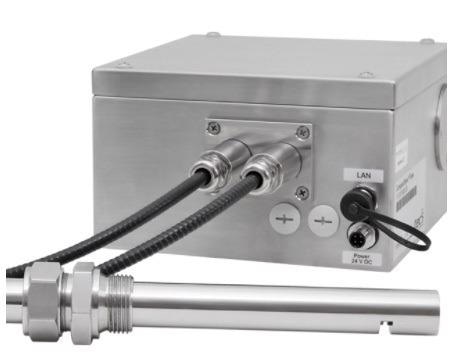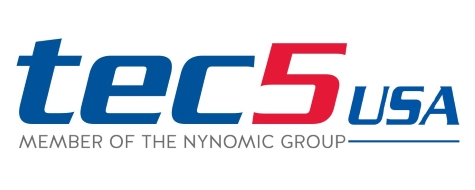Winemaking is generally believed to be more of an art than a science. Yet, the wine’s flavor profile, mouthfeel and other characteristics come from the relative concentrations and presence of various chemical species that give a wine its flavor profile.
By profiling and determining the chemical composition of wine, it is possible to gain insight into what makes a certain wine unique and this information can then be applied to the winemaking process to achieve specific results.
Flavor Profile and Flavor Compounds
Red wines typically have their flavor profiles divided into ten different categories: red wine, black fruit, herbaceous, floral aromas, vanilla, earthiness, baking spice pepper/spice, leathery flavors, astringency and body.
The five basic characteristics of wine are tannins, alcohol, body, sweetness and acidity.
The challenge with translating these details into a chemical analysis and categorization of the wine is that wine is an extremely intricate blend consisting of hundreds of different chemical species included across a wide range of chemical families.

Image Credit: tec5USA Inc
The primary families of flavor compounds of interest include esters, pyrazines, sulfur compounds and terpenes, among others. For instance, aroma profiles that are commonly described as floral or rose-like, green and herbaceous are generated by members of the terpene family of compounds.
As well as various terpenes producing different aromas, slight changes in the relative concentration of the chemical species also play a crucial role in establishing the wine’s overall flavor profile. In parallel, sugars, polyphenols and flavonoids all impact the sweetness of a wine and ethanol causes the resulting mouth-warming effect.
While also giving rise to the flavor and characteristics of the wine, winemakers must be able to quantify their product’s sugar and alcohol content. During the fermentation process, sugar and alcohol are the main reactants and products and so careful management of their concentrations is vital in optimal production.
Establishing the alcohol concentration is also necessary for the labeling and sales of alcoholic products.
What a great number of winemakers are now doing is utilizing online chemical analysis processes as part of intentional process control to create high quality wines or wines with individually tailored profiles. Chemical analysis can be utilized in every single step of wine production, such as during the aging or the fermentation of the wine.
For instance, modifying the particular blends of yeast used can intensify the complexity of the flavor profile and help to limit spoilage. One such analytical technique that works particularly well for qualitatively and quantitatively identifying the general flavor compounds in wine is near-infrared (NIR) spectroscopy.
NIR Identification of Functional Groups
NIR spectroscopy is a familiar analysis tool that can be utilized to determine the presence of overtones and combination bands of functional groups in a molecule with great efficiency.
Each molecule that absorbs NIR radiation has a distinct spectrum that can be used for explicit identification and with the appropriate calibration information, it can also be utilized for quantification.
NIR spectroscopy is exceptionally suited for the analysis of flavor compounds in wine as a majority of these have functional groups that very strongly absorb in the NIR region, so even detection of low concentrations is possible. Some of the identifiable compounds include ethanol, sugars, flavanols, etc.
The benefit of using NIR spectroscopy in favor of other analytical techniques such as liquid chromatography is that, with the appropriate instrument, the analysis can be completed online, with a considerable reduction in analysis times while being non-destructive.
For this purpose, tec5 can supply Compact NIR Spectroscopy Systems (CNIRS) that can be utilized for both characterizations of sugars, ethanol and other flavor compounds.
Inline NIR Analysis
For the wine industry, where online process optimization tends to be the goal, tec5’s CNIRS instrument is perfect as it can be fitted for inline analysis. The instrument covers the 1.10 – 2.50 µm wavelength range, so it confirms the compatibility standards for measuring sugars, alcohols and other flavor compounds, including lactone or phenolic species.
Process control applications will gain considerably from the exceptional achievable signal-to-noise ratio exceeding 10 000, which means analysis times and acquisition can be significantly reduced as well as detecting flavor compounds only present in low concentrations.

Image Credit: tec5USA Inc
Compounds that typically result in spoilage or undesirable tastes in wine can be detected by consumers at the ppt level, so the superior sensitivity of this device is crucial for facilitating the screening of contaminants.7
For techniques such as multivariate data analysis, tec5 has the option to provide state-of-the-art analytical software packages with the instrument. This means that, as well as simple installation of a single box device, the learning curve for optimal use of the spectroscopic data, is reduced.
There is a wide range of sample probes that are compatible with the CNIRS, including immersion probes for use in liquids that could be simply interfaced into existing processing equipment for online monitoring.
The idea is to provide a device that delivers a flexible, accurate and cost-effective alternative for batch sampling and offline analysis that can be utilized to react to unexpected changes in processing conditions.
Over the last few years, the use of NIR spectroscopy to determine the characteristics of wine has become a well-established methodology. Using tec5’s hardware solution of online analysis has numerous advantages, either for quality control and process monitoring or active process management for the production of perfectly tailored wines.
tec5USA Spectrometry Solutions
tec5USA produces a full suite of spectrometry solutions appropriate for inline analysis in the wine industry.
tec5USA’s Compact Near-Infrared Spectrometer (CNIRS) system is a compact, efficient and inexpensive alternative to conventional NIR spectrometers.
Predicated on a Micro-Electro-Mechanical System (MEMS) Fabry-Perot interferometer sensor, the CNIRS has the capacity to measure variable wavelength ranges within 1.10 – 2.50 μm, with a signal-to-noise ratio in excess of 10,000.
tec5USA integrated systems are available in a variety of enclosure types and allow for considerably cheaper sensor nodes when compared to traditional spectrometers.
The Compact UV-NIR Spectrometer generates a wavelength accuracy of less than 0.3nm and is permanently wavelength calibrated to guarantee reliably accurate measurements. The system is an extended-range UV/visible/IR spectrometer for measuring wavelengths in the 300 – 1100 nm range.
Inline monitoring offers unprecedented ease-of-use and precision, facilitating the continuous acquisition of measurements that are recorded automatically without human input and sample destruction.
tec5USA’s spectrometry systems offer a cost-effective, flexible and accurate alternative to expensive, laborious and destructive wet chemistry techniques for wine analysis.
These techniques offer improved control over the brewing of wines, allowing winemakers to monitor fermentation progress with great precision and obtain insight into flavor compounds to inform decisions in the winemaking process (for instance, adding oak chips or other barrel alternatives to simulate barrel-aging effects).

tec5USA CNIRS in a stainless-steel enclosure. Image Credit: tec5USA Inc
About tec5USA
Part of the publicly traded company Nynomic AG, tec5USA is the North American subsidiary of tec5 AG. The group is an international leader in the manufacturer of products for permanent, non-contact and non-destructive optical measurement technology.
Rather than holding out for time-intensive laboratory measurements, tec5USA's instruments measure time-critical chemical and physical parameters rapidly to react promptly to variations in the production line, permitting process verification in real-time.
This facilitates consistent quality, rework reduction and waste minimization, end-to-end supply chain optimization, yield maximization and pay per content.
The industries that tec5USA serves include semiconductor manufacturing equipment, thin-film technology, environmental technology, the mining industry, chemistry, petrochemistry, biotechnology and pharma, food, feed and beverages as well as agriculture.
References
1. Marais, J. (2017). Terpenes in the Aroma of Grapes and Wines: A Review. South African Journal of Enology & Viticulture, 4(2), 49–58. https://doi.org/10.21548/4-2-2370
2. Styger, G., Prior, B., & Bauer, F. F. (2011). Wine flavor and aroma. Journal of Industrial Microbiology and Biotechnology, 38(9), 1145–1159. https://doi.org/10.1007/s10295-011-1018-4
3. González, S. S., Gallo, L., Climent, M. D., Barrio, E., & Querol, A. (2007). Enological characterization of natural hybrids from Saccharomyces cerevisiae and S. kudriavzevii. International Journal of Food Microbiology, 116(1), 11–18.
4. Padilla, B., Gil, J. V., & Manzanares, P. (2016). Past and future of non-Saccharomyces yeasts: From spoilage microorganisms to biotechnological tools for improving wine aroma complexity. Frontiers in Microbiology, 7(MAR), 1–20. https://doi.org/10.3389/fmicb.2016.00411
5. Cozzolino, D., Kwiatkowski, M. J., Parker, M., Cynkar, W. U., Dambergs, R. G., Gishen, M., & Herderich, M. J. (2004). Prediction of phenolic compounds in red wine fermentations by visible and near infrared spectroscopy. Analytica Chimica Acta, 513(1), 73–80. https://doi.org/10.1016/j.aca.2003.08.066. NIR Systems - Spectrometer | tec5. https://tec5.com/en/products/nir-systems/, accessed 21st July 2020 7. Rapp, A. (1998). V
6. NIR Systems - Spectrometer | tec5. https://tec5.com/en/products/nir-systems/, accessed 21st July 2020
7. Rapp, A. (1998). Volatile flavour of wine: Correlation between instrumental analysis and sensory perception. Nahrung - Food, 42(6), 351–363.

This information has been sourced, reviewed and adapted from materials provided by tec5USA Inc.
For more information on this source, please visit tec5USA Inc.